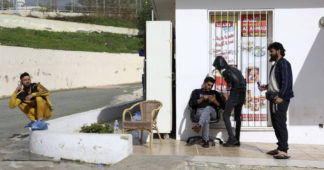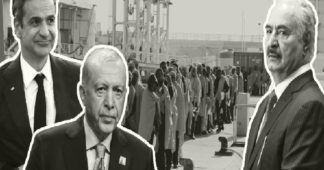By Orestis Nikiforou
Turkey today stands at a crossroad—hosting the largest refugee population in the world while also grappling with growing social tensions and economic strains. But does this truly amount to a “migration problem,” or is it rather a series of regional and policy challenges? A closer look offers a nuanced perspective.
Statistical Snapshot
Turkey’s population currently exceeds 85 million. As of 2024–2025, more than 3 million Syrians remain under temporary protection—depending on sources ranging between 2.9 and 3.3 million. In addition, around 1 million other foreigners reside in Turkey either with residence permits or under international protection.
Taken together, Turkey is home to over 4 million non-Turkish nationals—more than 5% of the country’s population, a staggering low figure compared to many European nations: Germany 14%, France 13%, Greece 11,3%, Italy 10,9%
A Burden or an Opportunity?
On one hand, the influx of migrants has imposed clear burdens:
– Economic pressures: Infrastructure, education, and healthcare systems, especially in urban centers like Istanbul (hosting alone 485.000 foreigners) and border provinces to Syria (where foreigners score up to 25-30% of the whole population), face added strain.
– Social tensions: The rise of xenophobic sentiment reached a peak in July 2024, with anti-refugee riots erupting across cities such as Kayseri.
On the other hand, there are notable economic contributions:
– Labor integration: Syrians fill critical gaps in sectors like agriculture, construction, and manufacturing.
– Entrepreneurship: Thousands of Syrian-owned businesses have emerged—some of which employ Turkish citizens and contribute to exports.
Yet, the economic benefits are tempered by the fact that:
– Most refugees work informally, with a small percentage holding proper work permits.
– Refugee children face educational gaps—by 2022, approximately 35% of school-aged Syrian children were not enrolled in Turkish schools.
Policy: Reactive, Ambiguous, Politicized
Turkey’s approach to migration has often been reactive rather than strategic:
– The “temporary protection” status given to Syrians offers basic access to services but no long-term residency or integration plan.
– Policy shifts—from calls for repatriation to welcoming rhetoric—have served political aims more than a coherent humanitarian or social strategy.
– Turkey is also a transit route into Europe. Though stricter border controls have reduced smuggling, irregular migration remains a serious concern.
EU policies facing migration to Turkey
– The EU, in return for managing refugee flows, has disbursed billions of euros to support refugees and host communities—but concerns about sustainability persist.
– The exact amount disbursed by the EU to address the migration issue in Turkey is a subject of debate while it is nothing more than a short term measure.
– There are serious concerns as to whether these funds are spent to meet the needs of the refugees rather than being mainly beneficial to Turkish state agencies.
– Regardless of EU funding the Turkish state has to fulfil its responsibilities towards the refugees.
Societal Fractures and Political Tensions
Recent events have deepened the sense of crisis:
– Riots and xenophobia flared up in 2024, leading to widespread damage and public unrest.
– Anti-refugee sentiments, often fueled by economic hardship, remain prevalent in many parts of society.
– Ongoing shifts in Syria’s political landscape have led to debates about voluntary returns—but many refugees remain rightfully reluctant due to ongoing instability, violence and persecution in Syria
Verdict: Is There a Migration Problem?
Nationally, the numbers—though large—are manageable in proportional terms (around 5% of the population). Turkey continues to provide shelter far beyond its diplomatic and economic weight.
Locally, however, the picture is different. Border cities and urban centers bear the brunt of resource strain, and social tensions flare without adequate local support or integration policies.
Systemically, the lack of a coordinated long-term plan, combined with politicization of migration and uneven enforcement, compounds fragility. It’s not simply “too many people,” but rather how migration is managed—or mismanaged—that creates the problem.
Looking Ahead: Recommendations
- Regularize labor: Enforce work permits and restrict informal labor, improving protections on both sides.
- Invest in integration: Expand education, health, and housing services with EU, UN, and planned national support.
- Promote social cohesion: Counter xenophobia through community programs and transparent aid distribution.
- Clarify legal frameworks: Provide clearer paths to residency or citizenship, reducing uncertainty and marginalization.
- Balance border management: Maintain humane reception for asylum seekers while curbing trafficking and irregular migration.
Conclusion
Turkey undeniably faces complex migration challenges—but labeling it simply as a “migration problem” overlooks the many dimensions at play. The core issue lies in policy and perception: the lack of long-term planning, rising xenophobia, political exploitation, and uneven territorial impact.
With better-structured strategies, community engagement, and international cooperation, Turkey’s migration landscape can shift from crisis management toward sustainable coexistence. The path forward hinges on governance that is humane, consistent, and informed by social realities—not purely political expedience.
We remind our readers that publication of articles on our site does not mean that we agree with what is written. Our policy is to publish anything which we consider of interest, so as to assist our readers in forming their opinions. Sometimes we even publish articles with which we totally disagree, since we believe it is important for our readers to be informed on as wide a spectrum of views as possible.











